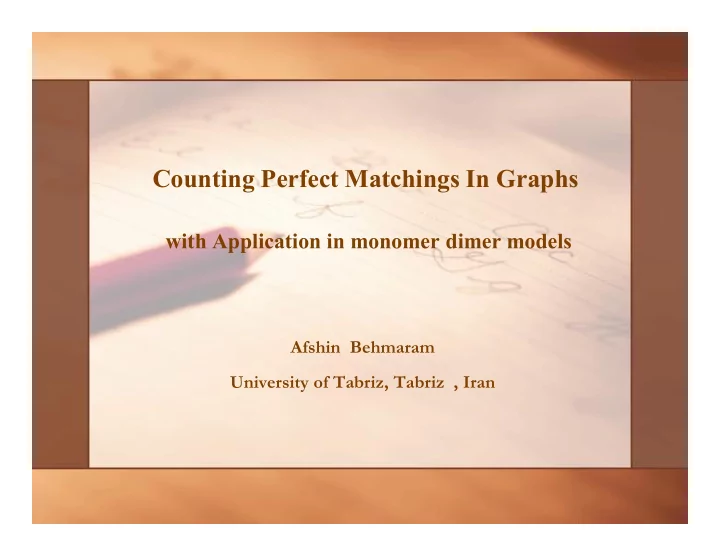

Counting Perfect Matchings In Graphs with Application in monomer dimer models Afshin Behmaram University of Tabriz, Tabriz , Iran
Definition • Let G be simple graph. A matching M in G is the set of pair wise non adjacent edges , that is ,no two edges share a common vertex. • Every edges of M is called dimer. If the vertex v not covered by M is called monomer . • If every vertex from G is incident with exactly one edge from M , the matching is perfect. The number of perfect matchings in a given graph is denoted by Pm(G )
Application Dominoes problem P × m P Pm( ) n
Introduction-Fullerene graphs: • A fullerene graph is a 3-regular 3-connected planar graph with pentagon or hexagon faces. • In chemistry, fullerene is a molecule consisting entirely of carbon atoms. Each carbon is three-connected to other carbon atoms by one double bond and two single bonds.
Introduction-Fullerene graphs: • By the Euler ’ s formula n − m + f = 2, one can deduce that : p = 12, v = 2h + 20 and m = 3h + 30 .
Introduction- matchings in molecular graph: • If two fullerene graphs G and H have the same vertices then: pm(G) ≥ pm(H) => G is more stable than H
Matching in fullerene • Doslic in 1998 prove that every fullerene graph have at least n/2+1 perfect matching. • H Zhang &F Zhang in 2001 prove that every fullerene graph have at least [3(n+2)/4] perfect matching. • Theorem (Kardos, Kral', Miskuf and Sereni, 2008). Every fullerene graph with p vertices has at least 2 (p − 380)/61 perfect matching
pfaffian of matrices: • Let A be n × n skew symmetric matrix. It is well known in linear algebra that if n is odd then: det(A)=0 • For skew symmetric matrix of size 4 we have: = − + A a a a a a a 2 det( ) ( ) 12 34 13 24 14 23 • In general case we have this theorem from Cayley: Theorem 1.1: for any n × n skew symmetric matrix A, we have: = A pf A 2 det( ) ( ( )) Where pfaffian of A is defined as:
pfaffian and matchings: • We say that the graph G has a pfaffian oriention , if there exists an oriention for edges of G such that : |pf(A)|=pm(G) • Theorem(Kasteleyn-1963). An orientation of a graph G is Pfaffian if every even cycle C such that G - V(C) has a perfect matching has an odd number of edges directed in either direction of the cycle.
Pfaffian and planar graph • Theorem(kasteleyn-1963) every planar graphs has pfaffian orientation. • Orient edges such that each boundary cycle of even length has an odd number of edges oriented clockwise .
Solving domino problem by pfaffian • Theorem(Kasteleyn-1963). Every planar graphs has pfaffian orientation. • Orient edges such that each boundary cycle of even length has an odd number of edges oriented clockwise . • Perfect matching=
Results in pfaffian and planar graphs r • Bergman inequality: let G=(A,B) is bipartite graph and let i are the degree of A then we have: 1 ∏ r ≤ pm G ( ! ) r ( ) i i d • Theorem (Friedland & Alon, 2008). Let G be graph with degree i ,then for the perfect matching of G we have: 1 ∏ ≤ d pm G d 2 ( ) ( ! ) i i • Equlity holds if and only if G is a union of complete bipartite regular graphs
Results in pfaffian and planar graphs d • Theorem (Behmaram,Friedland) Let G is pfaffian graph with degrees ,then i for the number of perfect matching in this graph we have: 1 ∏ ≤ pm G d ( ) 4 i • Lemma : For d>2 we have: 1 1 d ≥ d d 2 4 ( ! ) K • Corollary . is not pfaffian graph for r>2. r r , • Corollary. I f g is girth of the planar graph G then we have: n g 2 • ≤ pm G ( ) ( ) 4 − g 2 n ≤ pm G ( ) 2 2 • especially if G is triangle free then : •
Results in fullerene graphs-upper bound • Theorem 3.1. If G is a cubic pfaffian graph with no 4 – cycle then we have: n n ≤ pm G ( ) 8 12 3 12 • Theorem 3.2 . For every fullerene graphs F, we have the following inequality: n ≤ pm F ( ) 20 12
m-Generalized Fullerene • A connected 3-regular planar graph G = (V , E) is called m-generalized fullerene if it has the following types of faces: two m-gons and all other pentagons and hexagons. • Lemma. Let m ≥ 3 be an integer different from 5. Assume that G = (V,E) is an m-generalized fullerene. Then the faces of G have exactly 2m pentagons. • For m=5,6 , a m-generalized fullerene graph is an ordinary fullerene
m-Generalized Fullerene (circular latice) • The Family of m-generalized fullerene F(m,k): The first circle is an m-gon. Then m-gon is bounded by m pentagons. After that we have additional k layers of hexagon. At the last circle m- pentagons connected to the second m-gon. • Theorem. F(m,k) is Hamiltonian graphs.
m-Generalized Fullerene • Theorem. The diameter of F(m,k) is: • Theorem. For the perfect matchings in F(m,k) we have the following results:
The End Thanks your attention
Recommend
More recommend